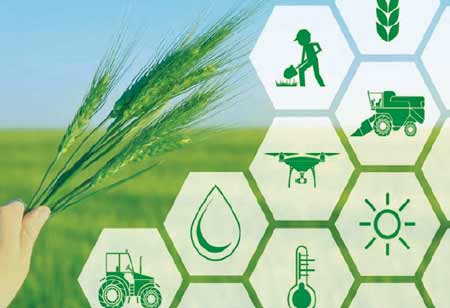Thank you for Subscribing to Agri Business Review Weekly Brief
Innovations Shaping The Global Agriculture Industry
Fertilizer manufacturing plays a crucial role in supporting global food production, supplying essential nutrients that enhance crop yields and promote agricultural productivity.

By
Agri Business Review | Thursday, September 26, 2024
Stay ahead of the industry with exclusive feature stories on the top companies, expert insights and the latest news delivered straight to your inbox. Subscribe today.
Fertilizer manufacturing plays a crucial role in supporting global food production, supplying essential nutrients that enhance crop yields and promote agricultural productivity. However, the industry is undergoing significant changes due to evolving environmental, economic, and regulatory pressures. The demand for more sustainable and efficient fertilizer products has led to a wave of innovations in manufacturing processes, product formulations, and delivery systems. The latest trends in fertilizer manufacturing focus on sustainability, precision agriculture, and advancements in nutrient management technologies. These developments aim to reduce environmental impact while enhancing the efficiency of nutrient use, ultimately shaping the future of global agriculture.
A key development in the fertilizer industry is the increasing emphasis on sustainability, particularly in the production of nitrogen-based fertilizers. Traditionally, nitrogen fertilizers are produced using the Haber-Bosch process, which relies heavily on natural gas as a feedstock. This process is energy-intensive, contributing significantly to greenhouse gas emissions. However, recent advances in green ammonia production are transforming this segment of the industry. Green ammonia is synthesized using renewable energy sources such as wind, solar, and hydropower instead of fossil fuels, reducing the carbon footprint of fertilizer manufacturing.
Another area of innovation in green technology is the development of bio-based fertilizers. These fertilizers are derived from organic waste, such as crop residues, animal manure, and food waste, and offer a more sustainable alternative to synthetic fertilizers. The use of bio-based fertilizers not only reduces dependency on finite resources, such as phosphate rock and natural gas, but also contributes to a circular economy by recycling nutrients that would otherwise go to waste. These fertilizers can improve soil health and structure, contributing to long-term agricultural sustainability. Various startups and research institutions are working on optimizing bio-based fertilizers for commercial use, making them a growing area of interest.
Advancements in digital technologies are also playing a significant role in shaping the future of fertilizer manufacturing. Precision agriculture techniques, supported by data analytics, satellite imagery, and machine learning, are revolutionizing how fertilizers are applied to crops. By using these tools, farmers can apply fertilizers more efficiently, reducing waste and environmental harm while maximizing crop yields. Precision fertilization ensures that the right amount of fertilizer is applied at the right time and in the right place, based on real-time data about soil health, weather conditions, and crop needs.
For fertilizer manufacturers, the integration of digital tools has opened new avenues for product development. Companies are increasingly offering "smart" fertilizers that work in tandem with precision farming equipment. These fertilizers are designed to release nutrients gradually, responding to specific environmental triggers such as soil moisture or pH levels. This approach not only enhances nutrient use efficiency but also reduces the risk of nutrient runoff, which can lead to water pollution.
Digital platforms are also being used to monitor and optimize the fertilizer supply chain. For example, blockchain technology is being explored to improve transparency in the sourcing and distribution of fertilizer products. This can help ensure that fertilizers meet quality and environmental standards, as well as reduce inefficiencies in transportation and storage. As digital tools continue to evolve, they are likely to play an even greater role in the fertilizer industry, driving improvements in both manufacturing and application processes.
The fertilizer manufacturing industry is also being shaped by changing regulatory and market dynamics. Governments worldwide are implementing stricter regulations to reduce the environmental impact of fertilizers, particularly regarding nutrient runoff and greenhouse gas emissions. The European Union's Farm to Fork Strategy, for example, aims to reduce nutrient losses by 50% and fertilizer use by 20% by 2030. Such regulations are pushing fertilizer manufacturers to innovate and adopt more sustainable practices.
At the same time, there is growing consumer demand for sustainably produced food, which is driving changes in agricultural practices and, by extension, fertilizer manufacturing. Organic farming, for instance, has seen a significant rise in popularity, creating a market for organic fertilizers and soil amendments. Fertilizer companies are responding by developing products that meet the needs of organic farmers, including slow-release fertilizers and bio-based solutions.
The global market for fertilizers is also being influenced by geopolitical factors, such as the availability of raw materials. Phosphate and potash, two essential nutrients used in fertilizers, are finite resources, and their extraction is concentrated in a few countries. As global demand for food rises, concerns about resource scarcity are prompting manufacturers to explore alternative sources of nutrients, such as recycled materials and biowaste.
The fertilizer manufacturing industry is undergoing a period of significant transformation, driven by the need for more sustainable and efficient agricultural practices. Green technologies, such as low-carbon ammonia production and bio-based fertilizers, are reducing the environmental footprint of fertilizer production. Digital tools and precision agriculture are enabling more targeted and efficient fertilizer application, while innovations in nutrient management, including nanotechnology and microbial-based fertilizers, are improving nutrient use efficiency. These advancements, along with evolving regulatory and market pressures, are reshaping the future of fertilizer manufacturing. As the world faces the dual challenges of feeding a growing population and addressing climate change, the continued evolution of the fertilizer industry will be essential for ensuring sustainable agricultural productivity.





